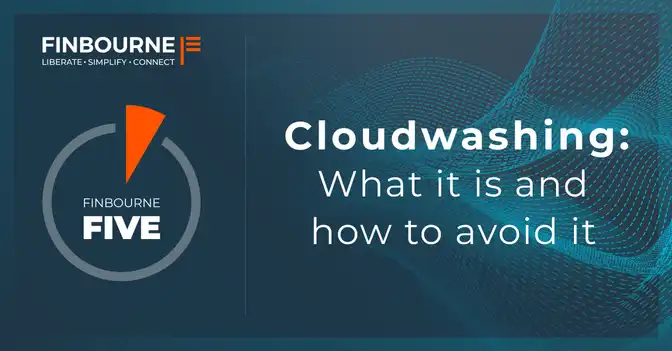Welcome back to FINBOURNE Five, our series that succinctly covers core data management methods or concepts in five minutes or less. In this piece, we will look at ‘Cloudwashing’, the practice of companies rebranding their existing on-premises or hosted solutions as “cloud-based” to tap into the growing market for cloud computing services.
Cloudwashing is often done in an attempt to appeal to customers who are looking for more modern, flexible, and scalable solutions that can be accessed from anywhere and at any time. The financial services industry has been relatively slow to adopt cloud computing, due to concerns about security and regulatory compliance. However, as the technology has become more mature and secure, and as regulatory requirements have evolved to accommodate cloud computing, more and more financial services firms are turning to the cloud to achieve operational efficiency via a scalable platform that improves application interoperability.
Over the past decade, nearly every major financial technology vendor has been marketing their ‘cloud capabilities,’ however, not all companies that claim to offer cloud-based solutions are actually providing true cloud computing services. Some companies may be using the term “cloud” to describe their existing on-premises or hosted solutions, which are still based on traditional, inflexible, and expensive infrastructure. These solutions may not offer the same benefits as true cloud-based solutions, such as scalability, flexibility, and cost elasticity.
By 2025, Gartner estimates that over 95% of new digital workloads will be deployed on cloud-native platforms, up from 30% in 2021’.[1] However, as firms increasingly look to embrace a cloud-first principle, distinguishing between true cloud-based solutions and cloudwashed solutions can be difficult. Many vendors use similar language and marketing materials to describe their offerings. To avoid being ‘cloudwashed’, you should look for the following key identifiers:
Challenges with data integration, and inefficiency are likely to persist no matter where the software is hosted. However, cloud SaaS platforms are the future for data collection and storage, and can deliver value to your organization quickly and incrementally. A true cloud-native approach to data management can deliver advantages right out of the box, allowing you to move on from data volume and storage issues, and freeing up your employees to drive business value in the cloud.
Fully-managed cloud-native data management platforms offer a dependable service which can grow with your business needs, and remove the operational burden associated with traditional on-premise solutions (capacity management, DR and BCP, high availability, backups, performance tuning, physical security).
At FINBOURNE, all our products are hosted on Amazon Web Services, and have been to design to take full advantage of the cloud. Our cloud-native solutions are scalable whether you are a large, complex multi-region asset manager, a global bank or a smaller wealth fund. They can be deployed in a modular fashion to ensure a data solution designed for your specific needs. To learn more about who we serve with our Modern Financial Data Stack, click here.
[1] https://www.gartner.com/en/newsroom/press-releases/2021-11-10-gartner-says-cloud-will-be-the-centerpiece-of-new-digital-experiences





